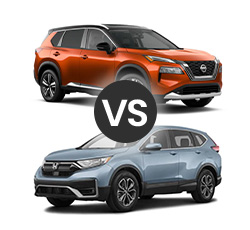2021 Nissan Rogue vs Honda CR-V
Two-row SUVs are heavily competitive on the market. Even though this can be overwhelming for prospective buyers, the newest models tend to offer great value and many advanced features so they stand out in a crowd. Nissan Rogue and Honda CR-V are two practical choices with many benefits; they're affordable, have stylish designs, spacious cargo areas, and high-tech systems available for drivers.
The Powertrain
The Honda CR-V is the superior of these two SUVs, boasting two available engines. In comparison, the Nissan Rogue only offers a 2.5-liter four cylinder that produces 181 horsepower and 181 pound-feet of torque - an impressive amount of power but nowhere close to matching what the Honda CR-V offers.
Whether you're looking to get the most out of your CR-V, or just want a stretch of extra power at your fingertips - Honda's got it covered. With options including 1.5L turbocharged engine and 190 horsepower plus 179 pound feet torque as well as hybrid version with 2 liters enhanced by an electric motor producing 212 horses – whatever kind of thrill ride is desired; there’s sure to be something that meets needs! And better yet: all wheel drive comes standard on Hybrid model versions making for some serious road handling pleasure.
Similarly, Nissan Rogue also offers available all-wheel drive. Although not everyone may require it regularly, some customers find their SUVs with all-wheel drive handy in certain scenarios. Many customers end up purchasing SUVs with this feature just in case they find themselves facing tough conditions occasionally.
On the Nissan Rogue, drivers have their choice of continuously variable transmission with manual mode or paddle shifters mounted on the steering wheel for precise shifting. Eco and Sport modes are standard on all Rogue trims; these do exactly as their names suggest. Furthermore, if a Rogue has all-wheel drive, then Snow and Off-Road modes will be available too.
Honda's CR-V offers a continuously variable transmission and Sport mode. An Eco Assist function helps drivers save gas, while an idle-stop feature temporarily turns off the engine when stopped for a few seconds.
The Honda CR-V has a reliable powertrain that yields impressive gas mileage, with an average of 28 mpg in the city and 34 on highways. Its Nissan Rogue counterpart is similar but offers only slightly more efficient figures - 27 mpg for urban roads and 35 out on the beltway. But if you're looking to maximize your savings at the pump, consider investing in its hybrid version which can provide up to 40 mpg around town or 38 when cruising down open highways.
Whether you're a camping enthusiast or simply looking to lend some hauling assistance, the Nissan Rogue and Honda CR-V can serve your mid-sized towing needs. With their combined 2,850 pounds of capacity between them - that's over 1¼ tons! - these small SUVs are anything but lightweights when it comes helping out with larger projects.
Drivability
These SUVs can be a pleasure to drive. They're lightweight and easy to handle, plus their open cabins make for an enjoyable journey. Both models have several extra features like remote engine start so the cabins can get warmed or cooled before passengers enter, as well as available smart entry systems which make key fob use much simpler; simply touch the handle to lock or unlock it!
Honda and Nissan models feature Hill Start Assist, which helps prevent SUVs from rolling backwards after being stopped on slopes. The program can keep pressure on the brakes as the driver gets ready to hit the gas pedal and get moving again. Another CR-V feature is Active Noise Cancellation which makes for a peaceful ride with minimal background noise.
When it comes to size, the Rogue and CR-V have almost identical dimensions. The Nissan Rogue measures 183 inches long, just an inch longer than its rival; both vehicles stand at about the same height with only half an inch difference in width between them; additionally, both sit eight inches off the ground - which is fairly standard for an SUV.
When it comes to passenger space and cargo capacity, small details can make a big difference. Anyone who has ever packed their car full of people and luggage knows the importance of these distinctions when transporting larger items in the cargo area or having taller adults ride in the back seat.
In the Nissan Rogue, front legroom measures 43.3 inches while back seat passengers enjoy 38.5 inches of leg room. By comparison, Honda CR-V provides less front legroom at 41.3 inches but more space in its second row with 40.4 inches of leg room for rear-seat passengers.
With room for more passengers and better cargo capacity, the Honda CR-V offers a compelling advantage over its Nissan Rogue counterpart. Featuring an impressive 75.8 cubic feet of space when all rear seats are folded down - shocking 39.2 with them up - it's no surprise why so many drivers opt to go big on this excellent crossover SUV option! However, those looking at the hybrid version should be advised that some interior storage is sacrificed due to fitting in battery and motor components; but still offering 68.7 cube feet when maximum seating has been lowered, plenty of items can fit quite nicely inside.
Modern consumers are likely searching for vehicles with cutting-edge features. Many rely on their smartphones every day, so these two SUVs make it simple to make calls, check messages, play music and do even more from the road.
On the Nissan Rogue, the top two trims feature eight-inch touchscreens with voice recognition, smartphone connectivity, SiriusXM radio and Bluetooth audio streaming. Most trims also have four total USB ports as well as Wi-Fi capability; some even include wireless charging or Apple CarPlay capabilities. On more premium models you may find a Bose premium audio system, nine-inch touchscreen or Nissan Door to Door Navigation system.
The Honda CR-V offers a similar infotainment package. Its top trim has integrated navigation, premium audio system and wireless charging. Most of its trims have Apple CarPlay, Android Auto, SiriusXM HD Radio and seven-inch touchscreens; however they lack as many USB charging ports as the Rogue does. Notably the base model of the CR-V only has five inches of LCD screen without smartphone compatibility though it does have Bluetooth capability.
To avoid overpaying on a new car, shop prices online first. Get up front pricing before you walk into a dealership. We recommend the following free services; Car Clearance Deals, NADAguides, CarsDirect & & Motortrend.
These free services will offer you the lowest prices and supply you with multiple competing price quotes. You will know the best price before you visit the dealer.
Safety
Nissan Rogue and CR-V feature a variety of driver-assist technologies, both models offering comprehensive safety packages that include not only anti-lock brakes and tire pressure monitoring but also several advanced features.
The Nissan Rogue boasts a host of standard features that come standard on every trim level, such as forward collision warning, automatic emergency braking and pedestrian detection. These all help reduce the chances of hitting another vehicle or pedestrian on the road. Plus, it features lane departure warning and intelligent trace control to assist drivers when they're drifting out of their positions. Furthermore, blind spot monitoring and rear cross-traffic alert are included along with automatic high beams and reverse automatic braking system for added peace of mind.
On certain Rogue trims, there is intelligent lane intervention so the vehicle can take a more proactive role in getting into its lane. Select models come with 360-degree cameras and blind spot intervention - meaning they'll correct steering and apply slight pressure to brakes if a driver changes lanes at an unsafe time. Many Rogues also have traffic sign recognition capabilities and adaptive cruise control for added peace of mind.
One additional advantage of driving the Rogue is its available head-up display. This display provides useful information such as warnings, speed limits and other pertinent details to drivers.
The base model of the Honda CR-V shares many similar features. It comes equipped with adaptive cruise control, automatic high beams, forward collision warning and collision mitigation braking as well as road departure mitigation, lane keeping assist, and lane departure warning to keep people where they should be. Unfortunately, there isn't a head-up display nor does it have a 360-degree camera available on this model.
Which Offers the Best Value?
Starting prices for both models are less than $5000 apart: the Nissan Rogue's S trim costs $25,750 while Honda CR-V's LX trim starts at $25,350. When making this decision it's important to remember that while CR-V offers slightly more power and size, Rogue boasts superior technology and safety packages. Both have cloth seats as well as manually adjustable front seats.
Honda CR-V EX trim costs $27,860; EX-L is $30,450 and Touring tops off the list at $33,650. With Nissan Rogue SV ($27,440), SL ($32,100) and Platinum ($35,530) are the remaining trims available.
As is evident, the Rogue is more expensive than the CR-V when comparing higher trims. This premium status comes with advanced technology and more modern features like tri-zone climate control, auto-dimming rearview mirror, interior accent lighting, remote folding rear seats with memory system for driver's seat and side mirrors, quilted semi-aniline leather upholstery - plus heating elements in front seats, rear seats, and steering wheel. While Honda CR-V also has some of these elements included in their model year 2014, they simply do not match up.
Another essential point is the additional cost of the hybrid powertrain on the CR-V. For some buyers, spending a few thousand dollars more may be worthwhile; however, others may find it unjustified.
Which SUV Is Better?
Before determining which SUV is ideal, potential customers must answer several essential questions.
Do they prioritize efficiency? If so, the hybrid CR-V would be the top pick. Are they seeking the most powerful powertrain available? In this comparison, the CR-V edges out. Is having the latest technology essential for safety and entertainment purposes? In this comparison, Nissan Rogue comes out on top.
Overall, these models offer plenty of advantages. Their spacious cabins, reliable powertrains and convenient features set them apart. However, the Nissan Rogue has more advanced technology features while the Honda CR-V boasts more power and interior space.

Get up to 4 local dealers to compete for your business by offering free, competitive pricing. Know before you go to the dealer.
Every dealer offers a secret price. Find yours here.
• 2021 Nissan Rogue VS Chevrolet Equinox
• 2021 Nissan Rogue VS Ford Escape
• 2021 Nissan Rogue VS Honda CR-V
• 2021 Nissan Rogue VS Hyundai Santa Fe
• 2021 Nissan Rogue VS Hyundai Tucson
• 2021 Nissan Rogue VS Kia Sportage
• 2021 Nissan Rogue VS Mazda CX-5
• 2021 Nissan Rogue VS Subaru Forester
• 2021 Nissan Rogue VS Toyota RAV4


